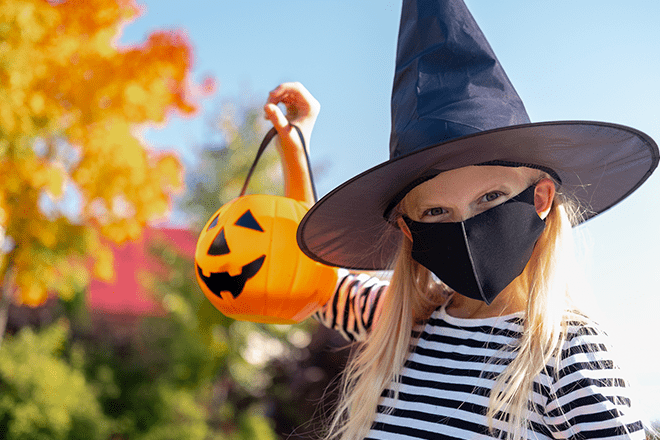
by North Shore Child & Family Guidance Center | Oct 20, 2020 | Blog
Are your youngsters excited about the upcoming holiday? Halloween is a favorite time of year for most kids, but this year brings some new challenges.
No one wants to take the joy of this annual fest/feast away from kids. To help keep them safe, the Centers for Disease Control and Prevention has put out some smart guidelines on trick-or-treating and other Halloween events.
Mask Up but Mask Right!
First, make sure that your child wears a mask—and that doesn’t mean one that comes with their store-bought costume. One strategy is to dress them up as a doctor or nurse so a surgical-type mask is a natural part of their outfit. But if they want to be a character from Disney or Harry Potter or just dress up as a traditional ghost or witch, in the time of Covid, masks are a must.
Important note: The CDC advises that it’s not a good idea to wear a costume mask over a cloth mask, since it can make breathing more difficult. Also, masks should not be worn on kids under two.
Handling Kids and Candy
The usual method of having children choose their treat out of a bowl or handing some treats to them are problematic this year, since safety requires as little physical contact as possible.
Some possible solutions: Set up a trick-or-treat “station” (or table) outdoors that has individually bagged treats that kids can pick up themselves. Spread them out a bit so each kid touches only his or her bag and be sure to wash your hands before stuffing the bags. You might even consider having hand sanitizer near the treat bags for kids to stay germ-free.
Since you may not want to miss greeting your young visitors, feel free to stand six feet or more away from your goodie bag table— and don’t forget to wear a mask yourself.
Tips for Trick-or-Treaters
Before heading out, make sure your children wash their hands after they’ve put on their protective masks. Bring hand sanitizer with at least 60% alcohol with you (or give it to your kids, if they are old enough to go out alone, typically 11 and up).
Going out in big groups increases the risk of transmission, so you may want to consider keeping it to just family or perhaps one or two good friends.
Once they bring home the booty, make sure they wash their hands thoroughly before eating any of it. If you want to be extra cautious, you could put it aside for a few days and have some candy on hand that you bought to tide them over.
The Usual Precautions
Pandemic aside, the normal safety advice applies to this year’s Halloween.
Some tips:
- Tell kids to cross only at corners, looking left, right and left again before crossing, and never run across the street.
- Ask them to leave the phones at home, or at least put them down so they can pay attention to where they are walking.
- If your older children are going alone, plan and review the route that is acceptable to you. Agree on a specific time when they should return home.
- Use reflective tape or stickers on costumes, which should never be too long to trip over. Carrying glow sticks or flashlights is also a good idea.
- Remember to drive with extra caution on Halloween, both day and night, since kids may dart in front of your car.
- Remove hoses, tools, bikes and other possible hazards from your front lawn and porch.
- Go through your kids’ candy before allowing them to eat it; throw away anything with a tear in the wrapper or that is homemade; and set limits on how much candy per day can be consumed.
- Protect your pets by keeping them inside and away from the front door.
- Never let a child of any age carve a pumpkin without close supervision—better yet, decorate with paint and stickers.
Finally, if you’re not comfortable sending your kids out this year due to the pandemic, there are alternatives. Some ideas: Hide candy around your house; visit a pumpkin farm or corn maze (bring masks and hand sanitizer) that is practicing social distancing; attend a scavenger hunt; hold a socially distanced costume parade; or host an outdoor movie night with a few close friends and neighbors.
Sources:
https://www.cdc.gov/coronavirus/2019-ncov/daily-life-coping/holidays/halloween.html?ACSTrackingID=USCDC_2067-DM40330&ACSTrackingLabel=Tips%20for%20Trick%20or%20Treating%20and%20Other%20Halloween%20Activities%20%7C%20COVID-19&deliveryName=USCDC_2067-DM40330
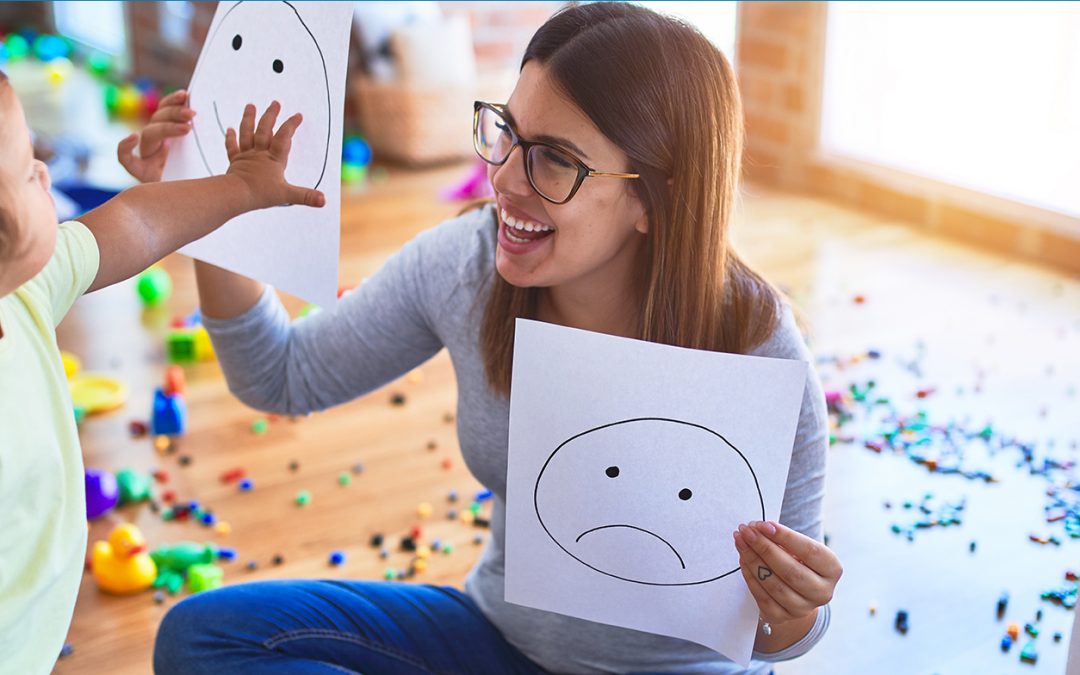
by North Shore Child & Family Guidance Center | Oct 17, 2020 | Ask The Guidance Center Experts, Blog
In this new monthly column, therapists from North Shore Child & Family Guidance Center will be answering your questions on issues related to parenting, mental health and children’s well-being. To submit a question, email NSCFGCexperts@gmail.com
Question: My son and daughter are athletes on their school’s sports teams, and they’re really struggling with the loss of these activities due to the pandemic. How can I help them deal with this difficult situation?
—Sports Mom
Dear Sports Mom: Being part of organized sports is such an important part of life for many of our children and teens, and you’re correct in describing this as a loss.
The many benefits of sports to a child’s physical and mental well-being are well known. Sports help kids develop fine motor skills, reduce stress and boost their immune systems. Children who participate in sports tend to have greater self-esteem. They learn teamwork, responsibility and perseverance, and they develop lasting friendships.
Many of our kids are experiencing a deep sense of grief. They’ve not only lost sports, but also many other important activities and the many relationships closely tied to those experiences.
As with any disappointment, encourage your child to discuss their feelings instead of keeping them all bottled up. You never want to give the impression that this isn’t a big deal. It is!
While they may want to spend more time on their screens, it’s important to set limits. Too much screen time is likely, in the long run, to make kids feel more isolated, unmotivated and demoralized. It’s fine to relax those rules to some degree, allowing for the diversion and connection with their peers, but don’t abandon reasonable limits altogether.
Perhaps your most important tool is to create other opportunities to keep your child healthy and engaged. Those could include family walks or other physical activities, such as practicing drills together or doing an online exercise class.
Although we don’t have a timetable for when the pandemic will be over, let your kids know that the best medical experts in the world are working on the solution and that you are optimistic that things will return to normal.
Question: Our daughters, one in middle school and the other in elementary, were taunted by one of their classmates because they are Chinese Americans. The boy called them derogatory names and said that they caused the pandemic. What can we do to protect them from this type of discrimination?
—Heartbroken Parents
Dear Heartbroken Parents: Sadly, anti-Asian bias has been widespread throughout the country and right here on Long Island. Verbal and even physical assaults against kids and adults have risen dramatically.
Your first job is to listen to your children closely and validate their feelings. They are likely frightened, angry and even embarrassed—all normal responses to such a traumatic event. Tell them they have nothing to be ashamed of and being bullied is not their fault.
Report the incident to their teacher, guidance counselor and principal. Suggest that they discuss bias and racism in the classroom and assemblies. Students need to be taught that any type of racist behavior or slurs will not be tolerated. They also need to learn about the value of diversity from a very early age.
Some more important steps:
- Advise your children to record these interactions with their phones as soon as they begin.
- Give children age-appropriate facts about the virus, so they know no culture is responsible for the pandemic.
- Model the behavior you want to see in your children by being anti-racist yourself.
- Teach them to stand up for themselves respectfully without escalating the situation further.
If the bias is an ongoing problem or there is any physical harm or threat of harm, contact the police, and make sure your children know to dial 911 if they are ever in danger. You can also report the incident to Nassau County’s Office of Asian-American Affairs at (516) 572-2244.
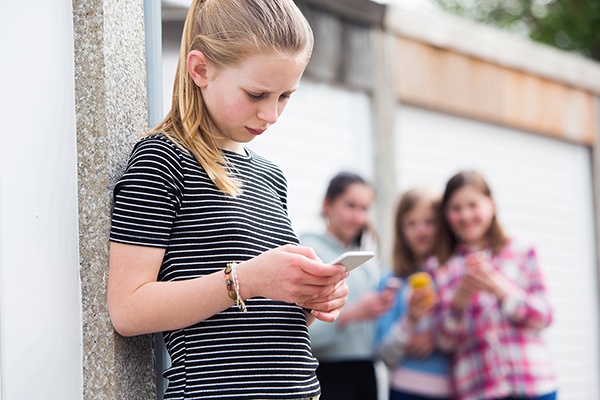
by North Shore Child & Family Guidance Center | Oct 12, 2020 | Blog
Bullies have been around since time immemorial, but with the heightened tensions and anxieties in our country related to the virus, politics, racism and more, children and teens are experiencing an increase in conflict and bullying incidents.
Bulling comes in four basic forms:
Verbal bullying involves the use of spoken words, with the bully threatening or calling someone by degrading names. It may also involve the use of slurs toward family or friends of their target.
Physical bullying involves hitting, kicking, pushing or any form of unwanted touch.
Relational bullying is when the bully purposely excludes his or her victim from activities, groups or events.
Cyberbullying is when someone uses Facebook, Instagram, texting or other social media to spread rumors and lies about another person.
While bullying can happen at any age, middle school is a particularly active time for bullies to do their worst. Here are some bullying facts:
- One out of every five students reported being bullied.
- Of those students who reported being bullied, 13% were made fun of, called names or insulted; 13% were the subject of rumors; 5% were pushed, shoved, tripped or spit on; and 5% were deliberately excluded from activities.
- Students who experience bullying are at increased risk for depression, anxiety, sleep problems, poor grades and dropping out of school.
- The reasons for being bullied reported most often by students include physical appearance, race/ethnicity, gender, disability, religion and sexual orientation.
- Students who reported frequently bullying others and students who report being frequently bullied are at increased risk for suicide-related behavior.
Bullies use intimidation as a tool to keep their victims quiet, which makes many kids reluctant to report the behavior. That’s why it’s very important for schools to tackle this subject directly, educating students on what bullying is and what they can do when they witness it or experience it themselves. In fact, research indicates that school-based bullying prevention programs decrease bullying by up to 25%.
Dr. Sue Cohen, director of North Shore Child & Family Guidance Center’s Marks Family Right from the Start 0-3+ Center, treats many children and teens who have experienced bullying, and advises them to use their power to speak up.
“Look the bully in the eye and tell him or her to stop in a calm, firm voice,” she says. “If it seems unsafe, walk away immediately. Either way, tell a trusted adult about the incident.”
Confronting the bully directly may be frightening, she adds, so often it’s easier for the child to tell a parent, teacher or counselor. “Since silence only encourages the bullying behavior, speaking out is crucial. Keep the lines of communication open with your child.”
The prevalence of social media and other technologies has made bullying more pervasive than ever, so kids need to be taught smart ways to protect themselves online—and also how to not be a bully themselves. “Teach your children to be kind to others and to never post anything out of anger or that is gossip,” says Cohen. “Also, let them know they should never pass on a nasty message, photo or rumor about anyone.”
Parents should be on the lookout for signs that their child is using verbal or physical aggression to deal with conflict; talking about getting even with others; or suddenly has items that don’t belong to him/her.
Finally, if you are a parent and your child is being bullied at school or by other students outside of school, don’t confront the bully or the parents. Contact the school principal or guidance counselor, and contact the police if your child is threatened with harm.
Sources:
https://www.stopbullying.gov
https://www.pacer.org/bullying/resources/stats.asp
http://www.stompoutbullying.org/
https://www.huffingtonpost.com/jamie-davis-smith/bully-that-tips-for-kids-and-parents-for-dealing-with-bullies_b_7829724.htmlhttp://www.sduhsd.net/documents/Parents%20and%20Students/School%20Safety/F%20-%20Bullying%20Statistics%202014%20-%20Facts.pdf
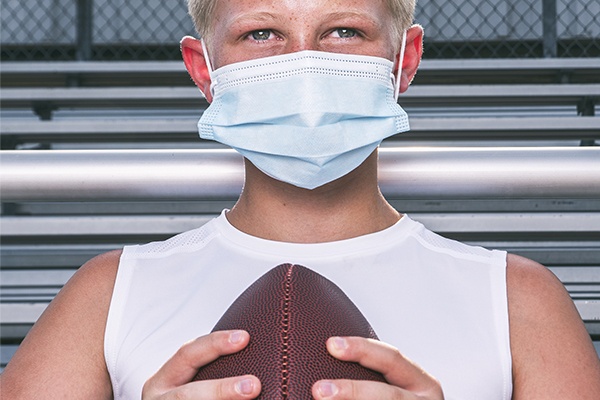
by North Shore Child & Family Guidance Center | Oct 8, 2020 | Blog
As of the beginning of the 2020 school year, officials in both Nassau and Suffolk County have put organized school sports on hold. While opinions vary as to whether this is a good idea, what’s important for parents is knowing how you can support your children’s physical and mental well-being during this difficult time.
Andrew Malekoff, Executive Director of North Shore Child & Family Guidance Center, was a multi-sport athlete during his school career and says that being involved in sports provided great opportunities for him. “Participating gave me something to look forward to every season, year-round,” he says. “It kept me out of trouble after school and on weekends.”
But it was more than a distraction, he emphasizes. “From an emotional growth perspective, sports can teach lessons about competition, cooperation, perseverance and resilience.”
The many benefits to a child’s physical and mental well-being are well known. Sports help them develop fine motor skills, reduce stress, boost their immune systems and maintain a healthy weight, which makes them less likely to experience a range of medical problems. Children who participate in sports tend to have greater self-esteem; they learn teamwork, responsibility and develop lasting friendships.
How to Help your Child Deal with the Loss
As with any disappointment, encourage your child to discuss their feelings, as opposed to keeping them all bottled up. “Many of our kids are experiencing a deep sense of grief from what they may experience as a devastating loss,” says Malekoff. “They’ve not only lost sports, but also many other important activities and the many relationships closely tied to those experiences. Try your best to keep an open dialogue, validating their experience and acknowledging that it’s a lot to deal with. You never want to give the impression that this isn’t a big deal. It is!”
You can also help by being a role model for how to deal with loss. Stay calm and try to be encouraging without dismissing how badly they feel. Don’t minimize the impact. “Although we don’t have a timetable for when the pandemic will be over, let your kids know that the best medical experts in the world are working on the solution and that you are optimistic that things will return to normal,” says Malekoff.
While they may want to spend more time on their screens, it’s important to set limits. “Too much screen time is likely, in the long run, to make kids feel more isolated, unmotivated and demoralized,” says Malekoff. “It’s OK to relax those rules to some degree, allowing for the diversion and connection with their peers, but don’t abandon reasonable limits altogether.”
Perhaps your most important tool is to create other opportunities to keep your child healthy and engaged. Those could include family walks or other physical activities, such as practicing drills together or doing an online exercise class. (To read about the benefits of physical activities on children’s mental health, read our blog, “Get Excited About Exercise.”)
Precautions to Take If You Decide to Keep Your Child in Sports
During the pandemic, some parents have chosen to keep their children active in sports through community youth leagues, private or group instruction, or even just through games with other children. That is a personal decision for each family to make. But there are guidelines created by the Centers for Disease Control and Prevention that can protect your child if they participate in sports.
To reduce risk, here are some important tips:
- Let players, coaches and others know that if they are experiencing any symptoms of illness, they should stay home (they should also remain at home if they have been in contact with anyone who is ill).
- Designate appropriate spacing using tape on floors or fields for drills and downtime.
- Tell spectators to socially distance and wear masks.
- Discourage carpooling.
- Teach appropriate hygiene and safety measures, which means washing hands for at least 20 seconds; using hand sanitizer when soap isn’t available; not sharing towels or other items; discouraging high fives and fist bumps; creating distance during breaks and whenever possible; and wearing masks at all times.
Since the situation is evolving, it’s wise to keep up to date on the health department regulations statewide and by county. Click here for more information.
For more information:
NYU Langone created a webinar to advise parents regarding steps they can take to foster a safe return of their kids to youth sports.
You can listen here.
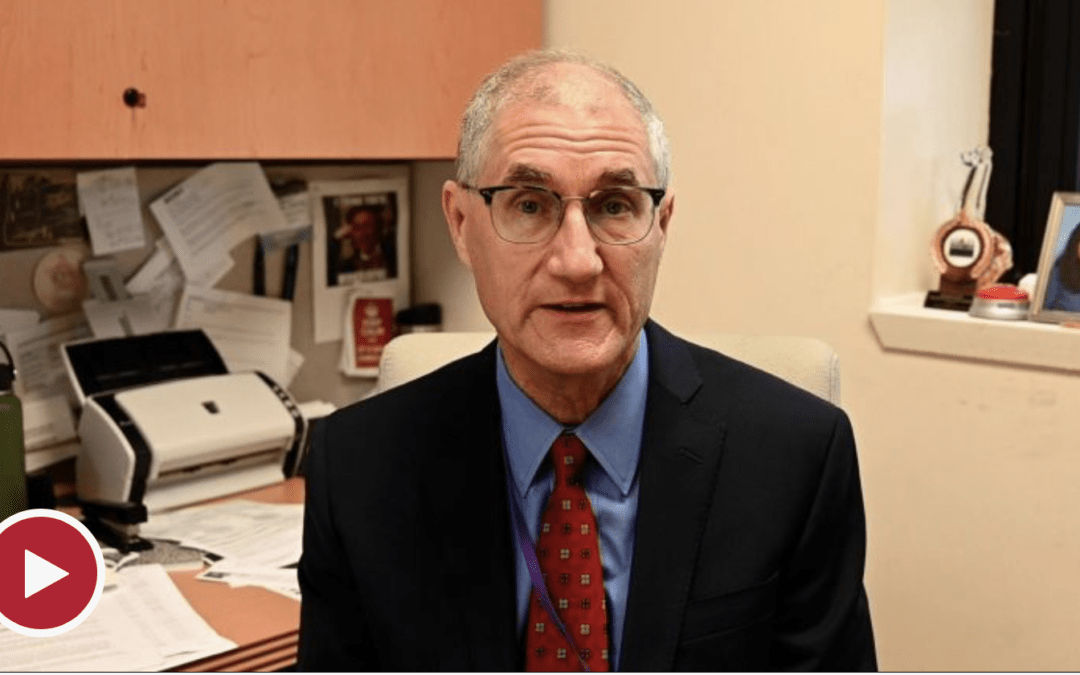
by North Shore Child & Family Guidance Center | Oct 5, 2020 | Blank Slate Media, In The Media
By Lisa L. Colangelo and David Reich-Hale, October 4, 2020
Six months after New Yorkers first hunkered down in response to the COVID-19 pandemic, the initial shock may have eased but the stress and anxiety have lingered, according to mental health experts.
The demand for counseling and therapy has increased as Long Islanders wait to see if schools can remain open, brace for flu season or even anticipate a possible second wave of COVID-19.
“There’s this sense that everyone’s waiting for the other shoe to drop,” said Dr. William Sanderson, a psychologist and director of the Anxiety & Depression Clinic at Hofstra University. “We aren’t really sure as we go into fall, are we going to be back where we were in March and April?”
In June 2020 on average, 36.5% of adults in the U.S. reported symptoms of anxiety and depression, according to the U.S. Census Bureau’s Household Pulse Survey. Between January 2019 and June 2019, 11% of adults reported those symptoms.
Health care providers are using a mix of telehealth and in-person visits to facilitate support groups, individual therapy and family therapy for people grappling with fear, anxiety, depression and other challenges stemming from the pandemic.

“A silver lining of the COVID pandemic is that it pushed mental health, full-force, into telehealth.” Dr. Adam Gonzalez, the director of Behavioral Health at Stony Brook Medicine
“A silver lining of the COVID pandemic is that it pushed mental health, full-force, into telehealth,” said Dr. Adam Gonzalez, the director of Behavioral Health at Stony Brook Medicine. “We saw a decrease in cancellations and no shows because of telehealth.”
At NYU Winthrop, demand for mental health services skyrocketed.
The pandemic “has a ripple effect on almost every layer of society,” said Dr. Aaron Pinkhasov, chairman of the Department of Psychiatry at NYU Winthrop Hospital, which has seen a 40% increase in demand for mental health services.
The ferocity of the news cycle has added to the stress, with reports of clusters of new casesemerging in New York and even the president and first lady testing positive in recent days.
No age group has been spared, Pinkhasov said. The lack of social contact has been especially difficult for young children as well as senior citizens. Then there is the pressure on adults caring for their children and aging parents, in many cases while working from home.
“Right now, more than ever, it’s important to expand mental health services and also educate primary care physicians, pediatricians, geriatric doctors and make them aware of the problem,” Pinkhasov said.
‘A chronic malaise’
During the height of the pandemic, the daily toll of infections, hospitalizations and deaths was grim and overwhelming. In April, over 700 New Yorkers died in one day.
But the percentage of new COVID-19 cases has hovered around a relatively low 1% for many weeks. The spread of the virus was slowed by the economic shutdown and individuals wearing masks, sheltering in place and avoiding crowds. The success came at a price.

“It cost us emotionally because a lot of it had to do with withdrawal and reductions in our lifestyle … now people are dealing with more of a chronic malaise.” Dr. William Sanderson, psychologist and director of the Anxiety & Depression Clinic at Hofstra University
“It cost us emotionally because a lot of it had to do with withdrawal and reductions in our lifestyle,” Sanderson said. “The shock is over and now people are dealing with more of a chronic malaise.”
Health care workers on the front lines fought hard to help patients, while dealing with their own stress, said Dr. Curtis Reisinger, a psychologist and director of Northwell’s Employee and Family Assistance Program, which offers confidential counseling services.
“We saw an eightfold increase in the number of people who called us after COVID,” Reisinger said. “We are still up 20% from what normal levels were.”

“We saw an eightfold increase in the number of people who called us after COVID.” Dr. Curtis Reisinger, psychologist and director of Northwell’s Employee and Family Assistance Program
He said that increase has come, in part, because people who might have been uncomfortable asking for assistance, realize how helpful talking to a therapist could be.
“The access is also that much better, because of telehealth,” Reisinger said.
Twenty-year-old Kelly Christ of Manhasset is hoping her struggles with anxiety will help others feel more comfortable to reach out for help. The Fordham University senior wrote blog posts and ran social media for the North Shore Child and Family Guidance Center this summer in an effort to help destigmatize the need to seek treatment.
“It was really good to have a person to talk to,” said Christ. “It made me feel like I wasn’t all alone, because sometimes if you’re talking to family and friends, you feel guilty.”
Others have seen existing mental health conditions aggravated.
John Lindstrom, 48, of Hicksville said his “depression has gone up a great deal” during the crisis.
Lindstrom, diagnosed with bipolar disorder in 2007, said he has only recently started to reconnect with family and friends after feeling severely isolated in his basement apartment during the height of pandemic — too fearful to venture out to a 7-Eleven store.
While he has continued telehealth, he misses the camaraderie at the Central Nassau Guidance and Counseling Services in Hicksville where he spent time several days a week.
Back-to-school worries
The excitement of children returning to school has been replaced with anxiety for parents and children, experts say.
“We are seeing a lot of school-aged children dealing with the aftermath of quarantine isolation and having to get used to a whole new world,” said Dr. Janet Kahn-Scolaro, administrative director of Behavioral Health, at Mount Sinai South Nassau Hospital. “There is a fear of the disease, not just for them but for their parents.”
Kahn-Scolaro said parents should be educated on how to help children process what they are seeing and hearing about the pandemic.
“Little kids hear a whole lot of stuff,” she said. “They never process it the way adults think they do.”
Regina Barros-Rivera, associate executive director at Roslyn Heights-based North Shore Child and Family Guidance Center, a not-for-profit children’s mental health agency, said children are missing beloved rituals such as birthday parties, picnics and the routine of going back and forth from school.
“I find parents who can offer structure can have more success,” she said. “Perhaps it’s a corner of a room that becomes their classroom. Create as much of a routine as possible.”
Winter days ahead
The warm summer months have given quarantine-weary Long Islanders a chance to get outside and safely visit with friends and family. But the long, lazy beach days are giving way to a brisk fall and earlier sunsets.

“As the weather turns colder a lot of us are fearful of what that means in terms of continuing to socialize.” Dr. David Flomenhaft, director of the outpatient Behavioral Health Services at Mercy Medical Center
Click to watch the video
“As the weather turns colder a lot of us are fearful of what that means in terms of continuing to socialize,” said Dr. David Flomenhaft, director of the outpatient Behavioral Health Services at Mercy Medical Center, which has seen a 20% increase in referrals over the last six months.
Flomenhaft said people should maintain routines, get exercise and avoid staying up late watching TV — even if they are working from home.
He is hopeful many can adapt: “We believe that people can grow and improve having survived difficult times.”
With David Olson
SOME PLACES FOR SUPPORT
SOURCE: Newsday Research.










